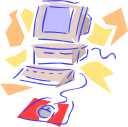
Chickering, A.W. and Ehrmann, S.C. (1996). Implementing the seven principles: Technology as lever. From AAHE Bulletin, October. Available online at www.aahe.org/technology/ehrmann.htm. Accessed 18 February 2002. The "Seven Principles of Good Practice in Undergraduate Education" form the basis of this discussion about using technology in the classroom.
CNET (2002). Tech trends: The decade in computing, part 3: Trends. Available online at www.cnet.com/techtrends/0-6014-7-308594.html. Accessed 18 February 2002. This is a quick look at current trends in computing.
Davies, G. and Hewer, S. (2002). Introduction to new technologies and how they can contribute to language learning and teaching. Available online at www.ict4lt.org/en/en_mod1-1.htm. Accessed 23 February 2002. This is part of the ICT4LT series of teacher training modules at www.ict4lt.org/en/index.htm and offers a good overview of what "new technologies" are and why they can be useful.
Healey, D. (2002). Evaluating sources. Available online at oregonstate.edu/dept/eli/july1996.html . Accessed 23 February 2002. A Tech Tip for teachers, offering ways to evaluate online sources.
Healey, D. and Johnson, N. (1998). A place to start in selecting software. Available online at www.onid.orst.edu/~healeyd/cj_software_selection.html. Accessed 19 February 2002. This offers guidance for teachers trying to find language teaching software that will work for their students.
McCarthy, B. (1999). Integration: The sine qua non of CALL. CALL-EJ Online, 1 (2). Available online at www.lerc.ritsumei.ac.jp/callej/4-2/mccarthy.html. Accessed 22 February 2002. This article offers an overview of the issues in adding computers to the curriculum. It would be useful for both teachers and administrators.
Michelich, V. (2002). Streaming media to enhance teaching and improve learning. Technology Source. Available online at ts.mivu.org/default.asp?show=article&id=941. Accessed 18 February 2002. Streaming media such as audio and video on the Web will be increasingly useful in schools as more Internet capability becomes available. For now, this is more in the future trends area.
Wang, Y-M. (2000). Training teachers using computers: A process of familiarization, utilization, and integration. T.H.E. Journal, 27 (10), 66-74.
Warschauer, M. and Healey, D. (1998). Computers and language learning: An overview. Language Teaching, 31, 57-71.
Easton, E.L. (2002). English online: Materials for teaching and learning. Available online at www.eleaston.com. Accessed 19 February 2002. An extensive collection of links on a wide range of topics. Very useful for teachers looking for content-based lesson resources.
Healey, D. (2000). Tech tip of the month. Available online at oregonstate.edu/dept/eli/techtip.html. Accessed 19 February 2002. A collection of short tips for teachers who want to use computers and the Internet in their classrooms.
ICT4LT: Information and communications technology for language teachers. (2002). Available online at www.ict4lt.org/en/index.htm. Accessed 18 February 2002. The Socrates project in Europe shares its material for teacher training in technology to any educational institution. This site offers 15 training modules at three different levels, a great resource for teacher trainers.
KidsClick! (2001). Available online at sunsite.berkeley.edu/KidsClick!/. Accessed 19 February 2002. A search engine put together by librarians for children. This says what grade level each site is for and whether or not there are images. A good site for those concerned about safe content.
Kids Domain. (2002). Available online at www.kidsdomain.com/index.html. Accessed 19 February 2002. Another site for primary and secondary school teachers, with articles and lots of software to download organized by age group and by topic.
Kitao, K. and Kitao, S.K. (2001). On-Line resources and journals: ELT, linguistics, and communication. Available online at ilc2.doshisha.ac.jp/users/kkitao/online/ . Accessed 19 February 2002. Especially useful are the suggestions about keypals.
Opp-Beckman, L. (1999). PiZZaZ: People interested in zippy and zany zcribbling. Available online at darkwing.uoregon.edu/~leslieob/pizzaz.html. Accessed 19 February 2002. An extensive and useful collection of online writing activities.
Stevens, V. (2002). A Web resource for CALL lab managers and for teachers and learners of languages online. Available online at www.geocities.com/Athens/Olympus/4631/esl_home.htm. Accessed 19 February 2002. Very good links for those setting up a computer lab.
Krauss, M. (2002). ESL independent study lab. Available online at www.lclark.edu/~krauss/toppicks/toppicks.html. Accessed 19 February 2002.
Sperling, D. (2002). Dave's ESL cafe. Available online at www.eslcafe.com. Accessed 19 February 2002.
http://www.onid.orst.edu/~healeyd/qatar/biblio.html